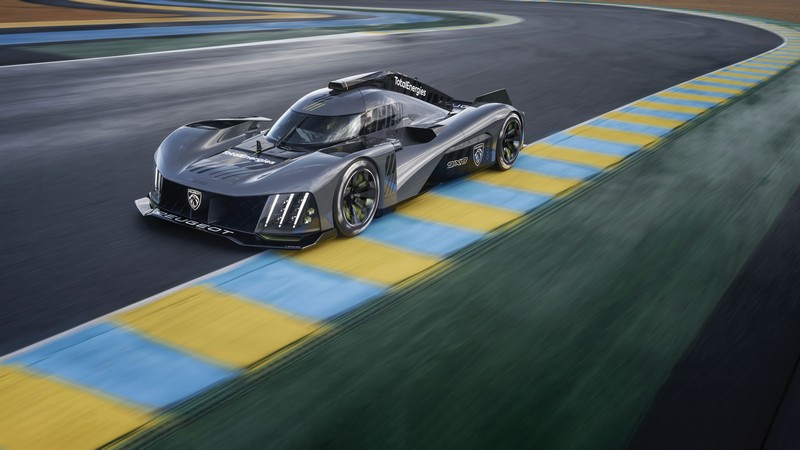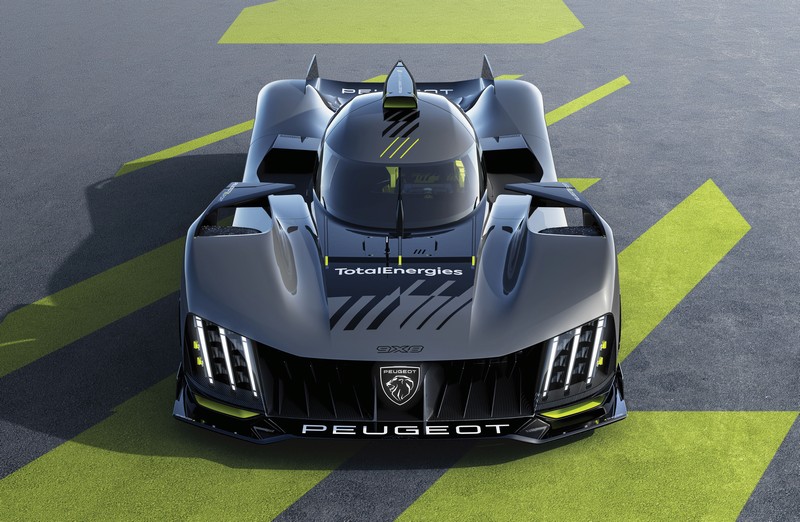Peugeot was the second of the large automotive manufacturers to sign up to the Le Mans Hypercar rule set, having not been represented in top-flight sportscar racing since the demise of the 908 project in 2012. With 2023 being the 100th anniversary of the endurance classic in Le Mans, it would have been unthinkable for Peugeot, ingrained as it is in the French racing psyche, not to compete for the overall win. When the company’s 9X8 Le Mans Hypercar broke cover it certainly caught the attention of fans and competition alike, mostly thanks to the lack of a rear wing.
Peugeot has well and truly embraced the spirit of the Hypercar rule set, bringing a previously unseen level of style to a race car. PMW caught up with Olivier Jansonnie, WEC program technical director for Peugeot Sport, at the 2021 Le Mans race, to find out how development of the 9X8 is progressing. Though the Hypercar rules were first announced in 2018, their exact direction remained in a state of flux for some time, and Peugeot did not sign off on the 9X8 project until later the following year.
“We started the first discussions around the global elements of the project at the end of 2019,” explains Jansonnie. “At first we were just trying to organize the various technical departments, and deciding how to work with technical partners and suppliers. Then starting in February 2020, development work on the car began properly.” One of the main selling points of the Hypercar rules was a sizeable cost reduction compared with LMP1.
According to Jansonnie, “We went through an exhaustive RFQ [request for quote] process with partners, checking the costs. From the very start, we really had to defend costs.” Cost constraints or not, Peugeot Sport was intent on maximizing the potential of the new rule set, and initially developed two concepts in tandem. “One was a more classical concept, the other something a bit more radical, more in the spirit of what we thought Hypercar should be,” recalls the Frenchman. “We got the styling department involved very early in the process. They looked at what we were doing, and we looked at what they were doing. Our second design concept was not so far away from what they envisaged, and we started to merge the ideas, which was a very interesting process.
 “We had to compare the two sets of ideas aerodynamically. Initially, their design was quite a long way from a race car, performance wise, but we went through a process of adding a bit of this and a bit of that. They were not huge changes [for the styling team] but made a big difference and enabled us to push things forward in terms of aero performance. We got to a point where the two models were not too far apart, and we could properly merge them into one. It was a long process, with a lot of discussion to find the best compromise.”
“We had to compare the two sets of ideas aerodynamically. Initially, their design was quite a long way from a race car, performance wise, but we went through a process of adding a bit of this and a bit of that. They were not huge changes [for the styling team] but made a big difference and enabled us to push things forward in terms of aero performance. We got to a point where the two models were not too far apart, and we could properly merge them into one. It was a long process, with a lot of discussion to find the best compromise.”
For the engineers at Peugeot Sport, in much the same way as their colleagues at Toyota and Glickenhaus, the freedom afforded by the BoP (balance of performance)-based rules took some time to aclimatize to. “The new regulations are completely different from what we are used to,” admits Jansonnie. “As race car engineers, we normally work with regulations preventing you from doing this or forcing you to do that. This shape is allowed, this one not and you just have to make the best out of it. Now we are just told what we need to achieve and given almost total freedom to do it. It has opened the door to many different approaches, and I think even more variations will be seen in the cars in the future.”
A question of balance
The 9X8’s aero design leans heavily on the underbody to generate downforce, to the extent that a rear wing was not deemed necessary – a very different approach compared with any race car Peugeot had developed in the past. Jansonnie is confident that his aerodynamicists have pursued the correct concept, but notes that it is still something of a leap into the unknown: “We have done a lot of wind tunnel testing and CFD, but we still need to validate on track. They are all different tools, and we need all three; the final truth will come when we get confirmation on the third one of them. We are confident, but not overconfident [that it will work].”
He also explains that the freedom the rules provide has removed some of the challenges inherent in its underbody aero concept. “It used to be a mandated shape under there and at the back. Now you are allowed to do whatever you like and there are much more powerful ways of working under the floor. It is not without risk though.”
 Could the reliance on the underfloor make the car more sensitive to changing conditions, especially with platform control tools such as inerters and interlinked suspension no longer an option? “I think that was definitely the case with the former LMP1 regulation, where if you were trying to do work on the floor, you were often increasing the [aero] sensitivity,” he suggests. However, this was due to the rules forcing LMP1 teams to push the aerodynamic performance within artificial constraints, which is no longer an issue in Hypercar. “Achieving the target downforce [in LMH] was not an issue; it was a two-week job, basically,” remarks Jansonnie. “The key developments were finding the sensitivities on the floor and using the greater freedom to reduce them. However, there is still more potential sensitivity than there would be with a wing. It is very difficult to assess properly in CFD or the wind tunnel and also, we don’t know how much sensitivity the drivers will be able to handle, and that needs to be checked.”
Could the reliance on the underfloor make the car more sensitive to changing conditions, especially with platform control tools such as inerters and interlinked suspension no longer an option? “I think that was definitely the case with the former LMP1 regulation, where if you were trying to do work on the floor, you were often increasing the [aero] sensitivity,” he suggests. However, this was due to the rules forcing LMP1 teams to push the aerodynamic performance within artificial constraints, which is no longer an issue in Hypercar. “Achieving the target downforce [in LMH] was not an issue; it was a two-week job, basically,” remarks Jansonnie. “The key developments were finding the sensitivities on the floor and using the greater freedom to reduce them. However, there is still more potential sensitivity than there would be with a wing. It is very difficult to assess properly in CFD or the wind tunnel and also, we don’t know how much sensitivity the drivers will be able to handle, and that needs to be checked.”
As for the removal of the rear wing, normally a key tool for adjusting the aero balance of the car, Jansonnie says the team has been working on other tuning options to ensure it still has sufficient scope to balance from track to track. “The regulation allows you to have one adjustable device on the car to adjust the balance. We have to decide on the final form of that device, and it is something we will be freezing at the very last minute. We have some options available, which can be at the front or the rear, and each of those options has some strong and weak points.”
Peugeot is aiming to complete initial track testing of the 9X8 by December this year, ahead of its 2022 debut. As Jansonnie says, the development schedule is punishing, but if the team’s calculations are correct, the striking design will give weight to the idea of Hypercar as a class where road car manufacturers can truly make their mark.



